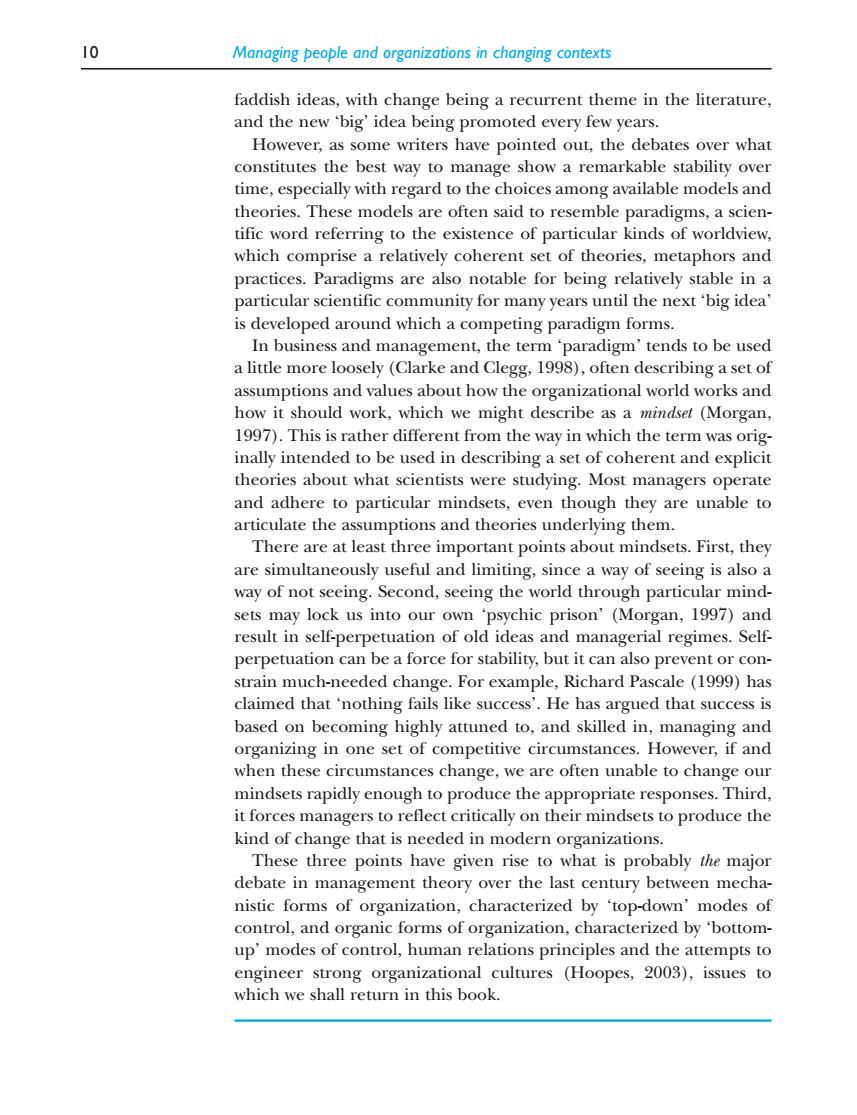正在加载图片...

10 Managing people and organizations in changing contexts faddish ideas,with change being a recurrent theme in the literature and the new 'big'idea being promoted every few years. However,as some writers have pointed out,the debates over what constitutes the best way to manage show a remarkable stability over time,especially with regard to the choices among available models and theories.These models are often said to resemble paradigms,a scien- tific word referring to the existence of particular kinds of worldview which comprise a relatively coherent set of theories,metaphors and practices.Paradigms are also notable for being relatively stable in a particular scientific community for many years until the next 'big idea is developed around which a competing paradigm forms. In business and management,the term'paradigm'tends to be used a little more loosely(Clarke and Clegg,1998),often describing a set of assumptions and values about how the organizational world works and how it should work,which we might describe as a mindset(Morgan 1997).This is rather different from the way in which the term was orig- inally intended to be used in describing a set of coherent and explicit theories about what scientists were studying.Most managers operate and adhere to particular mindsets,even though they are unable to articulate the assumptions and theories underlying them. There are at least three important points about mindsets.First,they are simultaneously useful and limiting,since a way of seeing is also a way of not seeing.Second,seeing the world through particular mind- sets may lock us into our own 'psychic prison'(Morgan,1997)and result in self-perpetuation of old ideas and managerial regimes.Self- perpetuation can be a force for stability,but it can also prevent or con- strain much-needed change.For example,Richard Pascale (1999)has claimed that'nothing fails like success'.He has argued that success is based on becoming highly attuned to,and skilled in,managing and organizing in one set of competitive circumstances.However,if and when these circumstances change,we are often unable to change our mindsets rapidly enough to produce the appropriate responses.Third it forces managers to reflect critically on their mindsets to produce the kind of change that is needed in modern organizations. These three points have given rise to what is probably the major debate in management theory over the last century between mecha- nistic forms of organization,characterized by 'top-down'modes of control,and organic forms of organization,characterized by'bottom- up'modes of control,human relations principles and the attempts to ).to faddish ideas, with change being a recurrent theme in the literature, and the new ‘big’ idea being promoted every few years. However, as some writers have pointed out, the debates over what constitutes the best way to manage show a remarkable stability over time, especially with regard to the choices among available models and theories. These models are often said to resemble paradigms, a scientific word referring to the existence of particular kinds of worldview, which comprise a relatively coherent set of theories, metaphors and practices. Paradigms are also notable for being relatively stable in a particular scientific community for many years until the next ‘big idea’ is developed around which a competing paradigm forms. In business and management, the term ‘paradigm’ tends to be used a little more loosely (Clarke and Clegg, 1998), often describing a set of assumptions and values about how the organizational world works and how it should work, which we might describe as a mindset (Morgan, 1997). This is rather different from the way in which the term was originally intended to be used in describing a set of coherent and explicit theories about what scientists were studying. Most managers operate and adhere to particular mindsets, even though they are unable to articulate the assumptions and theories underlying them. There are at least three important points about mindsets. First, they are simultaneously useful and limiting, since a way of seeing is also a way of not seeing. Second, seeing the world through particular mindsets may lock us into our own ‘psychic prison’ (Morgan, 1997) and result in self-perpetuation of old ideas and managerial regimes. Selfperpetuation can be a force for stability, but it can also prevent or constrain much-needed change. For example, Richard Pascale (1999) has claimed that ‘nothing fails like success’. He has argued that success is based on becoming highly attuned to, and skilled in, managing and organizing in one set of competitive circumstances. However, if and when these circumstances change, we are often unable to change our mindsets rapidly enough to produce the appropriate responses. Third, it forces managers to reflect critically on their mindsets to produce the kind of change that is needed in modern organizations. These three points have given rise to what is probably the major debate in management theory over the last century between mechanistic forms of organization, characterized by ‘top-down’ modes of control, and organic forms of organization, characterized by ‘bottomup’ modes of control, human relations principles and the attempts to engineer strong organizational cultures (Hoopes, 2003), issues to which we shall return in this book. 10 Managing people and organizations in changing contexts